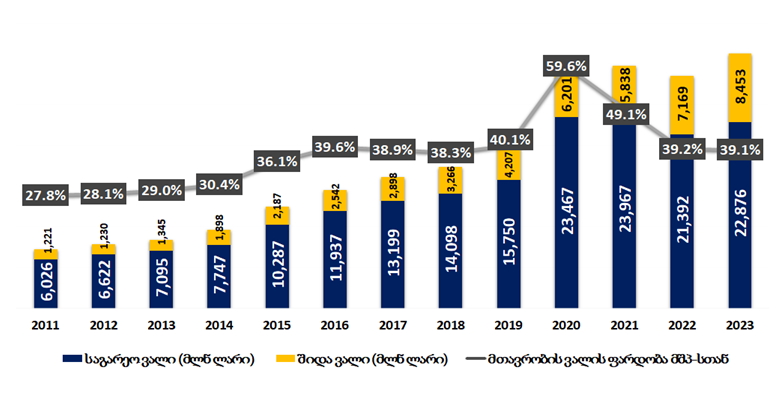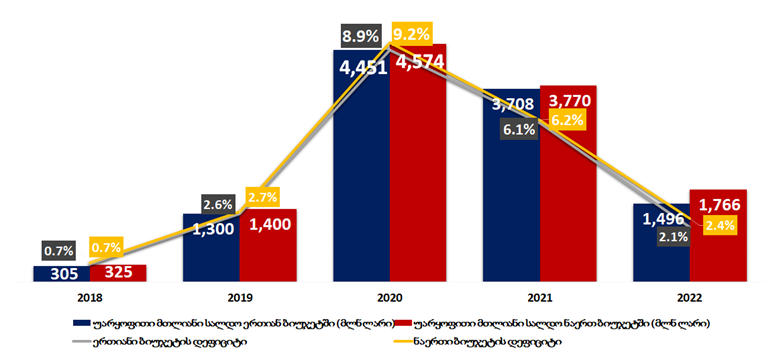Lasha Khutsishvili: “The budget deficit has reduced from 9.3% to 2.5% of the GDP and government debt has declined from 60.4% to 39.3% in 2020-2023.”
Verdict: FactCheck concludes that Lasha Khutsishvili’s statement is MOSTLY TRUE.
The budget deficit and the volume of government debt serve as key metrics for evaluating financial stability, both regulated by the Act of Economic Freedom, which sets the limit of 60% of GDP for government debt and 3% for budget deficit.
Government debt reached 59.6% of the GDP (60.2% as per the revised value of the GDP) whilst the budget deficit amounted to 9% during the 2020 economic crisis.
The economy expanded at a double-digit growth rate in 2021 and 2022 with an above-average growth rate of 7.5% observed in 2023. These positive macroeconomic factors led to the reduction of the debt-to-GDP ratio to 39% whilst the deficit reached 2.5%. However, the aforementioned positive trend of overcoming the crisis was not unique to Georgia as most countries witnessed above-average growth rates in 2021 and the faster growth persisted in some in 2022.
Additionally, despite government debt returning to pre-pandemic levels, it, nonetheless, exceeds the 2014 figure by almost nine percentage points and the 2012 figure by 11 percentage points. Furthermore, the budget deficit was less than 1% in 2018.
Exchange rate fluctuations substantially impact both surges and declines in government debt as over 70% of its value is denominated in foreign currency. The average GEL-to-USD exchange rate totalled 2.83 in 2019, 3.14 in 2020 and 2.63 in 2023.
Considering the mostly correct presentation of data and trends but acknowledging the existence of certain inaccuracies and omission of crucial factors, FactCheck concludes that Lasha Khutsishvili’s statement is MOSTLY TRUE.
Analysis
The Finance Minister, Lasha Khutsishvili, during his presentation of the annual report in the Ministerial Hour of the Parliament, stated: (from 12:42) “The budget deficit has reduced from 9.3% to 2.5% of the GDP and government debt has declined from 60.4% to 39.3% in 2020-2023.”
The volume of government debt and the budget deficit serve as crucial metrics for evaluating financial stability. The volume of government debt is calculated in both absolute value and in ratio to the gross domestic product.
Whilst the absolute debt value holds limited information – such as, for instance, a USD 100 billion debt is substantially different for China versus Georgia – the debt-to-GDP ratio is predominantly used. It is generally accepted that more prosperous economies can sustain higher debt-to-GDP ratios in contrast to developing countries. Whilst Georgia’s government debt-to-GDP ratio is lower than 40%, the USA’s exceeds 110% and Japan’s exceeds 214%.
The Georgian Act of Economic Freedom was passed in July 2011. The law prohibits the government to take debt more than 60% and, moreover, limits the upper bound of the budget deficit[1] to 3%.
The volume of debt has not exceeded the 60% mark since the passage of the Freedom Act. Although initially reported that the aforementioned metric reached 60.2% in 2020, the ratio reduced to 59.6% following the revision of the GDP by GeoStat in 2023. However, despite the budget deficit exceeding the limit threefold in contrast to debt, the law was still not violated as the act permits two exceptions:
1) Emergency or war situations;
2) Economic contractions if the economic growth of two consecutive quarters fall below the same periods of the previous year by two percentage points.
Georgia experienced both of the above in 2020: apart from the state of emergency, a negative value of the GDP growth rate was observed – the GDP reduced by 6.3% (6.8% as per the previous calculations).
Regarding government debt, despite abiding by the law and a 0.6 percentage point difference, it is more crucial to determine whether the government debt exceeded the 60% mark. Notably, Lasha Khutsishvili stated the revised GDP growth rate of 7.5 rather than the pre-revision 7% but used the previous figure whilst highlighting the debt figures. The Minister was likely aiming to effectively present a faster progress.
Graph 1: Absolute and Relative Values of Government Debt

Source: Ministry of Finance of Georgia
In addition to overstating the rate of crisis management, Lasha Khutsishvili also overlooked the fact that although the current debt-to-GDP ratio returned to the pre-pandemic level, it is still almost nine percentage points higher when compared to 2014 and 11 percentage points higher when compared to 2012.
Moreover, exchange rate fluctuations substantially impact debt as more than its 70% is denominated in foreign currency. The average GEL-to-USD exchange rate totalled 2.83 in 2019, 3.14 in 2020 and 2.63 in 2023.
The latter part of Mr Khutsishvili’s statement highlighted the budget deficit. The Parliament approved the budget for 2020 in December 2019, including a planned 2.5% budget deficit. The onset of the pandemic and COVID regulations led to a reduction in the tax revenues as outlined in the budget. On the other hand, the efforts to combat the pandemic (treatment of the infected, subsidising utility bills and compensating for the unemployed) resulted in increased expenditures. The aforementioned increased expenses were covered by incurring additional debt.
The budget deficit is a negative total balance as outlined by the Budgetary Code of Georgia (Article 12). The total balance is the difference between the operating balance (the difference between income and expenditures) and non-financial assets.
The state budget recorded a deficit of GEL 4.264 billion, the aggregated budget included a negative balance of GEL 4.450 billion and the consolidated budget deficit amounted to GEL 4.574 billion in 2020.
On the one hand, the deficit totals 8.6% and, on the other hand – 8.9% (or 9% of the pre-revised GDP) and finally – 9.2% (or 9.3% of the pre-revised GDP). Which is correct? Many associate the budget with the state budget, however the Freedom Act limits the total negative balance of the aggregated budget and not the state budget.[2] However, the calculation should be based on the consolidated budget[3] as per the International Monetary Fund principles. The Finance Minister likely referred to the consolidated budget.
Graph 2: Budget Deficit

Source: Ministry of Finance of Georgia
The Ministry of Finance webpage features a report on the nine-month progress of the 2023 consolidated budget implementation. The negative total balance for 2023 amounted to GEL 2 billion instead of the planned GEL 2.4 billion, constituting 2.5% of the GDP according to the Treasury Report on the state budget. Projections for the 2024 budget mirror these figures. The variance across state, aggregated and consolidated budget deficits is usually marginal in absolute values; therefore, the aggregated/consolidated budget deficits are both expected to be near 2.5%. Although the budget deficit, similar to the government debt, has returned to the 2019 level, it still significantly exceeds the 2018 figure.
Lasha Khutsishvili accurately presents the key data and trends. Whilst it is true that government debt and the budget deficit in Georgia have returned to the pre-pandemic levels of 2019, this trend is not unique to Georgia. Furthermore, the Minister overlooks the fact that the current debt-to-GDP ratio is almost nine percentage points higher than the 2014 figure and 11 percentage points higher than the 2012 figure. Moreover, the budget deficit has expanded 3.5-fold as compared to 2018. Considering the accurate numbers but certain inaccuracies and the omission of crucial factors, FactCheck concludes that Lasha Khutsishvili’s statement is MOSTLY TRUE.
[1] Deficit – negative total balance calculated as the difference between the operating balance (the difference between income and expenditures) and non-financial assets.
[2] The aggregated budget comprises the central, autonomous republics and municipal budgets. Additionally, it includes the budgets of LEPLs.
[3] The consolidated budget comprises the central, autonomous republics and municipal budgets.








